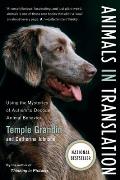 by Temple Grandin
by Temple Grandin
My dog doesn’t like change. He likes the same morning routine, at the same time, all the time. He likes treats to be predictable, although he won’t turn one down, ever. He knows the bedtime routine of treat-sleep. There are days he won’t eat breakfast unless I give him his glucosamine pills first. When I get dressed, he assumes “walk time,” even when I’m wearing a suit. I used to refer to him as, “my autistic dog.”
Little did I know.
Animals in Translation, by Temple Grandin, seeks to explain animal behavior, from a special point of view – that of a very high-functioning autistic adult. Grandin’s basic thesis is that her autistic brain functions similarly to that of animals, which allows her to think the way animals do. Of course, Grandin has most of the higher brain function of what she refreshingly calls, “normal people.” The idea being that a translator needs to be fluent in both languages.
Grandin may be familiar to some readers as Oliver Sacks’s Anthropologist on Mars. She’s the high-functioning autistic whose ability to empathize with cows has led her to design more humane equipment for stockyards and feedlots. (Don’t think the irony of this escapes her; nevertheless, she eats meat.) As a teenager at a boarding school, she designed a “squeeze machine” to comfort herself, after noticing the calming effect that deep pressure has on animals.
Animals in Translation is heavy on the brain chemistry, and hard on behaviorist theory. This doesn’t mean that training doesn’t work; if anything, it’s intended to direct it more humanely and efficiently. it does mean that the state of the art has advanced so far past the black-box theory of B.F. Skinner that we’ve been locating brain function in specific areas and chemicals for some time now.
If there’s an overarching theory to the book, it’s that the frontal lobes in autistic people don’t work very well, mimicking the depleted frontal lobes in animals. The frontal lobes are what allows generalization, but that generalization comes at a price: the filtering out of a great deal of raw information. When that filtering doesn’t happen, the brain gets overloaded; it’s as though every sensory input is turned up to 11. Things that you and I would overlook, like a plastic bottle on the ground or a yellow raincoat, will bring an entire line of cattle to stamping halt on their way through a plant. Grandin sees things that way, too, which is why she can design systems to reduce the need for electric cattle prods.
It’s also a fascinating look at evolutionary biology. Dogs have been domesticated from wolves, of course, essentially turned into permanent wolf-puppies, and the brain structure comparison between the two are instructive. (You may never look at your dog the same way again.) What’s more startling is the speculation that our close relationship with dogs – and our early dependence on their help – may have altered our own brain chemistry.
Grandin is autistic, and while she’s learned to string together enough phrases to simulate humor, one suspects that most of the cleverness comes from her co-author, Catherine Johnson. Still, the situational humor, the stories of neurotic animals (or neurotic owners) are all Grandin’s, and can be very funny at that.
While Grandin’s favorite animals are also your future lunch, there’s no evidence that she’s laboring to include cats and dogs just to appease a wider audience. What little repetition there is serves to drill in the key points. If anything, it could use an appendix describing all the various brain parts and chemicals, and their presumptive functions; it’s a shame to spend so much time wandering through the innards of your brain, only to discover that you can’t remember as much of the tour as you’d like.
Still, it’s a pleasure to read, and anyone interested in getting to know their pet better could do worse than to start here.